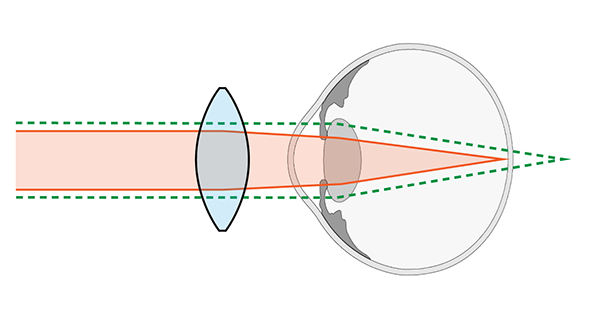Clinical Optometry
What is clinical optometry?
Optometry is the health profession that specialises in preventing, diagnosing and treating refractive errors (such as myopia, hypermetropia, astigmatism and presbyopia) and other conditions, such as accommodative and binocular dysfunctions. Optometry also deals with corrective lenses, such as contact lenses and ophthalmic lenses.
Types of refractive errors
- Myopia, or short-sightedness: This is a refractive error in which distant objects appear blurred. It is usually because the eye is too long, which makes images come into focus in front of the retina. It is a hereditary defect. Myopia magna is when the condition exceeds 6 dioptres. In these cases, patients are at greater risk of retinal problems.
- Hypermetropia, or long-sightedness: In this case, images come into focus behind the retina, usually because the eye is too short. If the refractive error is not too great, the eye can correct it with help from a lens, so it can be symptomless (especially in children). Initially it causes difficulties seeing things close up (reading, using the computer etc.) and can cause headaches when continuous effort is required to see things that are close by. When levels of refractive error are high, or when presbyopia appears, distant objects will also appear blurred.
- Astigmatism: In this case, the image is doubled in two focus points, which are shown in different positions. Depending on how separated they are, it causes objects to look fuzzier in a certain direction (like a watercolour with the ink running in one direction) and the image becomes distorted. Astigmatism affects objects at all distances. It is caused by an asymmetry in the cornea, which is more curved on one axis than the other (like a rugby ball). Sometimes it can be associated with corneal degeneration.
- Presbyopia (or tired eyesight): This condition is a natural loss of lens focus related to ageing, which makes it difficult to see from far away, and especially up close. Patients notice they have to extend their arm to read. Presbyopia increases with age, from about 40 to 60 years old, but progression will stop when the eye has lost all ability to focus.
Evaluation
Objective refraction test: Two methods are used, the retinoscope and the auto refractometer. There is no need for the patient to participate.
Subjective refraction test: For this test the patient will need to participate, providing feedback on which correction is best and/or which is most comfortable.
Accommodative and binocular vision test: A number of tests that assess joint movements in both eyes and the way they focus.
OTHER SPECIALITIES
Treatments
When correcting an error, what we do is to bring the image to the retina, as follows:
A diverging lens is used to correct myopia.
A converging lens is used to correct hypermetropia (or presbyopia).
A cylindrical lens is used to correct astigmatism.
There are three treatment types: glasses, contact lenses and refractive surgery.
- Glasses: Glasses consist of a frame with ophthalmic lenses that correct a refractive error. They may be:
- Monofocal lenses that focus on a single distance (far or near).
- Bifocal lenses have two different areas of vision correction, one near and one far.
- Multifocal lenses have several lens powers, covering all distances.
- Contact lenses: These lenses come into contact with the surface of the eye. Depending on their material, they can either be soft (with a high water content) or hard (with less flexible material). Multifocal contact lenses are used to treat presbyopia.
- Refractive surgery: This is a medical procedure that aims to remove the need to use glasses.

Treatment with glasses is most common in children.
Frequently Asked Questions
Yes, many headache problems are caused by a refractive error or binocular vision dysfunction.
No. The eye has a refractive error that needs to be compensated for in order to see as well as possible. What happens is that the brain adapts to any blurry vision by believing that it looks fine, when this is not the case. Once you can see clearly, the brain will not accept vision that is worse, which “forces” it to correct the error.
No. It is a natural and physiological process that takes place in the eye, like other similar processes in the human body (such as the menopause). There is no method or diet that can delay it.
Related entries
Is it important to check visual acuity in children?
When examining a child's eyesight, visual acuity entails measuring the smallest size of an object that can be seen with…







